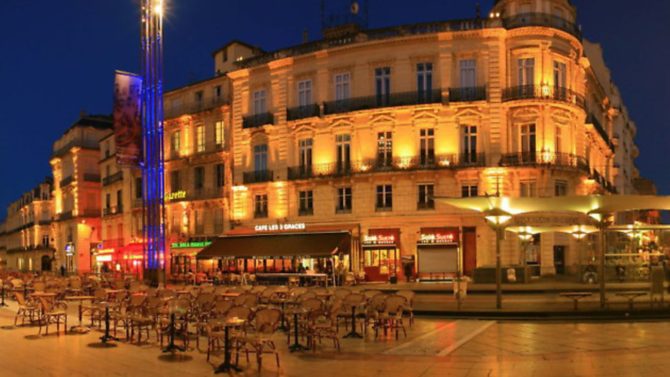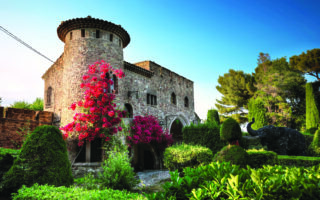Town, city, coast and country: 4 Hérault lifestyles explored


Mediterranean beaches, sleepy villages and vibrant urban areas – plus cheaper property than the Riviera. What’s not to like? Karen Tait explores Hérault

1. CITY: Montpellier
If you’re after the buzz of a city, an active nightlife, wide-ranging cultural attractions, restaurants and shops galore, and a lively economic hub offering a variety of work opportunities, look no further than Montpellier. France’s eighth largest city has a population of 268,456, closer to half a million in the wider Montpellier conglomeration.
A historic city with a modern outlook (France’s first gay marriage was held here in 2013), Montpellier is constantly attracting new residents from all over the country and Europe; for the past 25 years it has been the fastest growing city in France.

At the heart of the city, the huge main square, the Place de la Comédie, is one of Europe’s largest pedestrianised areas with beautiful historic buildings, in particular the spectacular opera house, and a multitude of restaurants and cafés. There are plenty more squares, narrow ‘old town’ streets and elegant boulevards to explore, as well as museums, art galleries and public gardens.
The pleasant Mediterranean climate encourages a relaxed atmosphere and a slower pace of life than in many other cities. Furthermore, with the coast on its doorstep there are lovely beaches close by including Espiguette, Palavas, Carnon and La Grande Motte, plus the Cévennes hills aren’t too far away for walking and other outdoor pursuits. And, of course, one of the benefits of a city location is that it offers year-round life and activities with plenty of festivals to enjoy too.
The efficient transport network, including a tram system, means Montpellier is easy to get around (a third of households don’t have a car), making it an ideal place to own a holiday home. There are easyJet (Gatwick and Luton) and Ryanair (Leeds) flights into Montpellier airport, while the TGV station puts Paris (with its Eurostar connection) just four hours away. Should you want to travel further afield, special €1 bus or train tickets will take you anywhere within the region.

Montpellier is a great place for buy-to-let investors too – in addition to tourists and the general population looking for somewhere to rent, the city’s acclaimed university, which dates back to the 12th century, provides one of France’s largest student communities.
Their presence is a big contributor to the city’s lively atmosphere – indeed, 50% of its inhabitants are under 39 – while the thriving local economy makes it attractive to entrepreneurs and jobseekers. Many high-tech companies have set up here, large and small, and industries include chemicals and pharmaceuticals along with tourism.
At €273,300 house prices are higher than the departmental average, as you’d expect for any regional capital never mind such a thriving one, but they’re still reasonable compared to other cities along the Mediterranean coast – for example, €334,500 in Marseille, €330,000 in Toulon and €335,000 in Nice.

Montpellier is home to many elegant Haussmann-style buildings, complemented by contemporary architecture, offering a choice of property styles for buyers – there are the usual terraced houses and villas in the suburbs too. As with any city, you need to research the different districts – the best way is to get out there and walk the streets. Try l’Écusson if you want old town character, Antigone for modern developments and Gambetta for lower prices.
2. TOWN: Pézenas

If your wish-list includes restaurants, shops, markets and a lively atmosphere, but a smaller, more intimate setting than the big city, Pézenas is perfect. Its many charms have already made it a big hit with tourists and househunters alike, and many Brits have bought property in the area.
Located between Montpellier (50km) and Béziers (20km), providing two airports to fly into from the UK, Pézenas is a particularly picturesque town, largely pedestrianised, with pretty squares and winding cobbled streets packed full of colourful boutiques. Lovely old stone buildings date from the 16th, 17th and 18th centuries, with courtyards, stone stairways and decorated facades. The town centre is a secteur sauvegardé, a protected area with strict building regulations, and is often used for TV period dramas.
With a population of 8,317, Pézenas is a small town with a lot going for it. Once home to the famous playwright Molière, it has a rich cultural calendar that encompasses everything from festivals to theatre and art galleries to cinema. It always feels busy, with a year-round Saturday market as well as many independent boutiques and antique shops. The town has a tradition of trade and prosperity – in the Middle Ages it was known for its fairs, becoming a royal town in 1262.

It was well located back then, and it’s even more accessible nowadays thanks to the A75 and A9 autoroutes. If Montpellier’s efficient transport system makes getting around the city easy, in Pézenas it’s even simpler as everything is within walking distance. The town is also close to the coast and mountains, and is surrounded by rolling countryside dotted with charming villages.
In terms of property prices, Pézenas offers good value, with lower average prices than the regional capital and coastal areas. However, all the attributes listed above make it more expensive than the department’s sous-préfectures, Béziers (population 72,970) and Lodève (population 7,552) in the north of the department, so those seeking a bargain may be drawn there instead.
Pézenas’s popularity means buy-to-let investors have a choice of full-time residents as well as tourists, with plenty of potential for short and long lettings.

“It’s the elegant period buildings and the winding cobbled streets that gives Pézenas its stylish and sophisticated feel and why it’s such a cosmopolitan town, with people of many nationalities making this their home,” says Deborah Plowright of Chez de Chez Properties. “That said, it’s still a living, breathing, working, French town that is proud of its local produce and traditions.
“While the majority of international buyers have outside space high up on their priority list, they then visit and fall in love with Pézenas and realise this really isn’t so important in such a vibrant town where you’ll want to be outside as much as possible, embracing all it has to offer.
“The most sought-after area is around the bustling heart of the old town, near Cours Jean Jaurès.”

3. COAST: Agde and around
While the coast is easily accessible from Montpellier and Pézenas, those who’d prefer to be right by the sea have a wide choice of locations.

Agde (population 24,651) is a mix of old and new – the town itself has historic buildings made from volcanic basalt rock, giving it the nickname the ‘black pearl of the Med’ (there are black sand beaches too), while Cap d’Agde and the marina area comprise modern apartment blocks and villas, with a few older fishing cottages along the coast.
Agde and Sète were once rival harbours, but gradually Agde became better known as a beach resort. With long sandy plages, watersports, an aquarium, and a wide choice of campsites, self-catering apartments and hotels, it’s a popular holiday spot – it is also home to Europe’s largest nudist colony. Although quieter out of season, it is close to more year-round life in Sète, Béziers and Montpellier, and as with the other towns in Hérault it benefits from good transport links.
At the other end of the Étang de Thau, a large lagoon known for its flamingos and oysters, Sète (population 44,558) is a larger harbour town with a wide range of shops and amenities, and, of course, a plethora of fish restaurants as well as more sandy beaches.

Between Cap d’Agde and Sète, Marseillan (population 7,884) is another popular spot. An old fishing port on the lagoon, it is known locally as Paradis sur terre, which gives you a hint of its acclaim. Surrounded by vineyards and olive groves, it has a choice of sporting activities, shops and restaurants, most offering the famous oysters and mussels farmed in the étang. The town has charming old buildings, some reflecting its Greek and Roman origins, and a covered market square. It is a town of two halves, with the other side being Marseillan Plage, home to sandy beaches and clear blue sea.
Property prices on the coast are more expensive than inland, as is typical throughout France, but are attractive compared to the Riviera resorts further east along the Med. Sète is the most expensive, reflecting its larger town status and work opportunities, while Agde comes next, with Marseillan offering the best value – just €2,615/m2.
When you compare that to the heady heights of the Riviera (€14,858/m2 in St-Tropez, for example), it’s clear that this area offers the Mediterranean on a budget without compromising on attractions. It may not be as glitzy as the Côte d’Azur, but it is also free from the crowds and affectations.

“I’ve been privileged to live in the very special town of Marseillan,” Deborah Plowright tells me. On the shore of the Étang du Thau and just a couple of minutes from the Mediterranean coast, you’ll find that fish, mussels, oysters and tielle (a sort of squid and tomato pie) dominate most menus.
“However, what’s great about living here can’t be judged by the number of restaurants or the elegance of its little port, as it’s more about the warmth of the people and the simplicity of life on offer.
“It’s great from a location point of view too. You’re cycling distance from the beach yet far enough away from the summer hordes to be able to meander around the quiet, pretty little streets all year round,” she adds.
“Properties are more expensive than the Hérault average with portside properties fetching premiums similar to Montpellier prices, but to live here is to experience all that is wonderful about the Mediterranean lifestyle, without the crowds or commercialisation.”
4. COUNTRY: Magalas area
There’s a vast choice of countryside to choose from in Hérault, from the Cévennes hills in the north to rolling vineyards further south. Within easy reach of Pézenas and the coast, as well as the airports and TGV stations at Béziers and Montpellier, Magalas (population 3,212) is one of Languedoc-Roussillon’s circulade villages.
Although small it has a couple of restaurants, art galleries and summer festivals, as well as an 11th-century church and rampart and castle remains. In the midst of vast vineyards, wine is naturally an important part of the local economy and many local producers offer wine-tastings.
Pouzolles (population 867) is another old wine village, whose fairytale twin-turreted château and church can be seen from far across the vineyards, as can Margon (population 588), a picturesque circulade with a stunning château, now a hotel. Another circulade, Alignan-de-Vent (population 1,623) has a twice weekly market in addition to shops. Further local villages include Laurens (population 1,514) and Autignac (population 875), both with medieval buildings and a sprinkling of shops and bars. Servian (population 4,310) and Roujan (population 1,954) are larger villages, with more facilities, restaurants and weekly markets as well as a rich heritage.
In contrast to Montpellier, Béziers and Pézenas, these tranquil villages offer old-world charm in a vineyard setting – this is undoubtedly an area for wine-lovers. If you’ve set your heart on a particular village you’ll find property is not as readily available as in the larger urban centres, but the wider area has a good choice of country and village houses.
Property prices are lower than in the cities and the coast, but higher than the hillside villages further north. In terms of average house price, the villages rank from least to most expensive as follows: Pouzolles, Roujan, Alignan-du-Vent, Servian, Laurens, Autignac, Magalas, Margon, with square metre prices ranging from €1,532 to €1,859.
“The Magalas area is very sought after as it is mainly made up of villages with amenities that are situated a short distance from the coast, rivers, lakes and the Haut-Languedoc natural park,” comments Freddy Rueda of Rueda Immobilier.
Like this? Then check out Explore Hérault in Languedoc-Roussillon and Heavenly Hérault
Share to: Facebook Twitter LinkedIn Email


